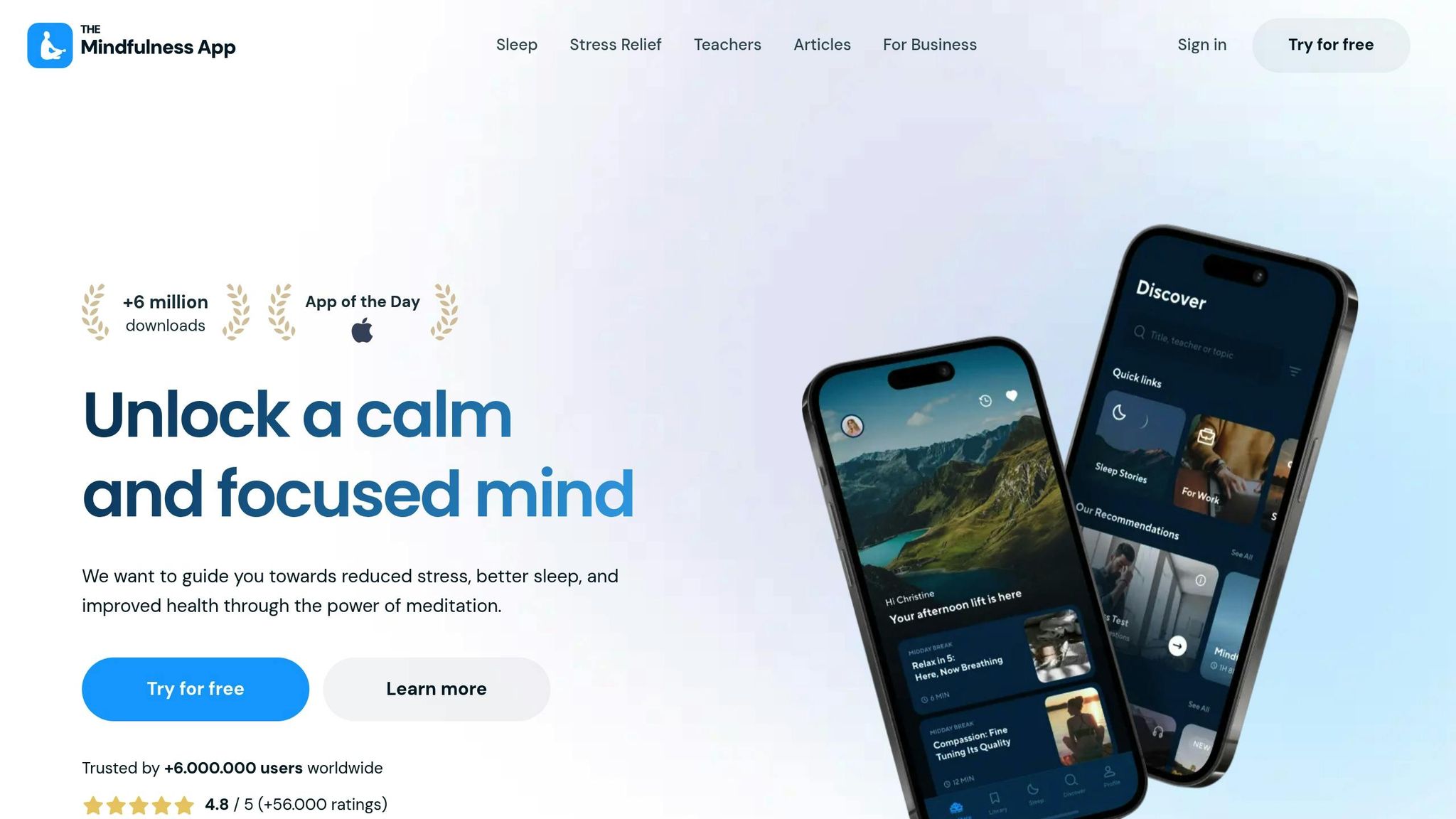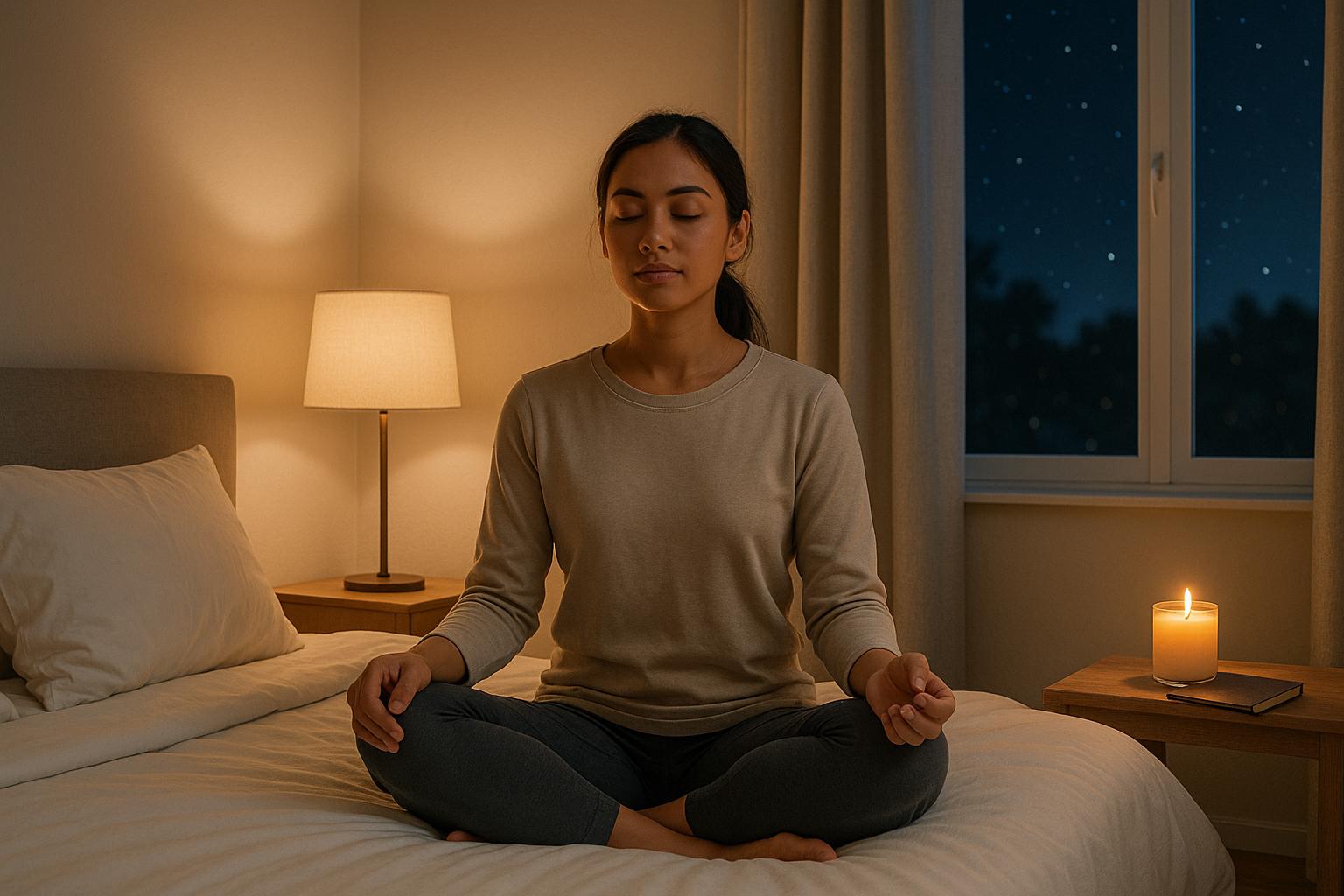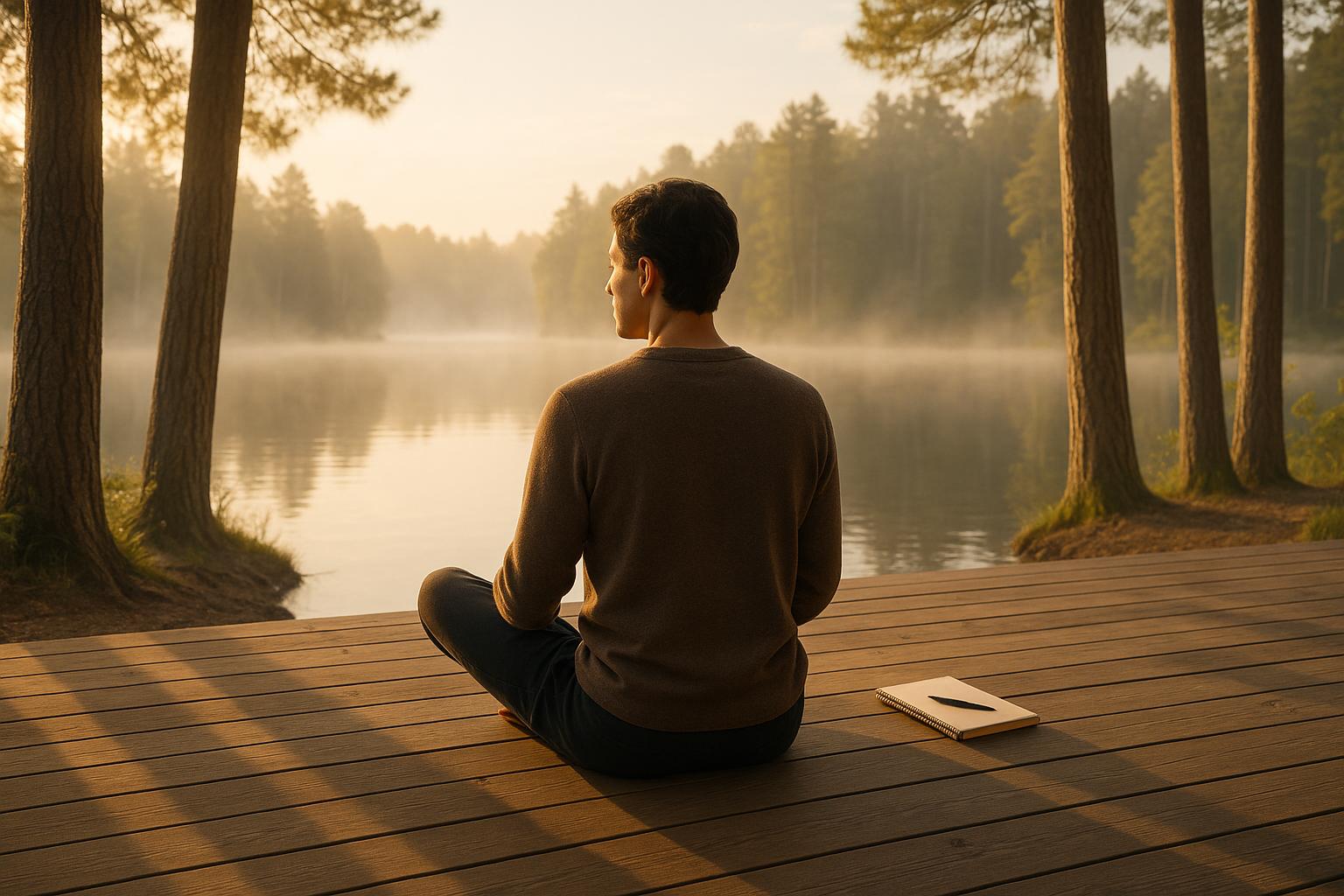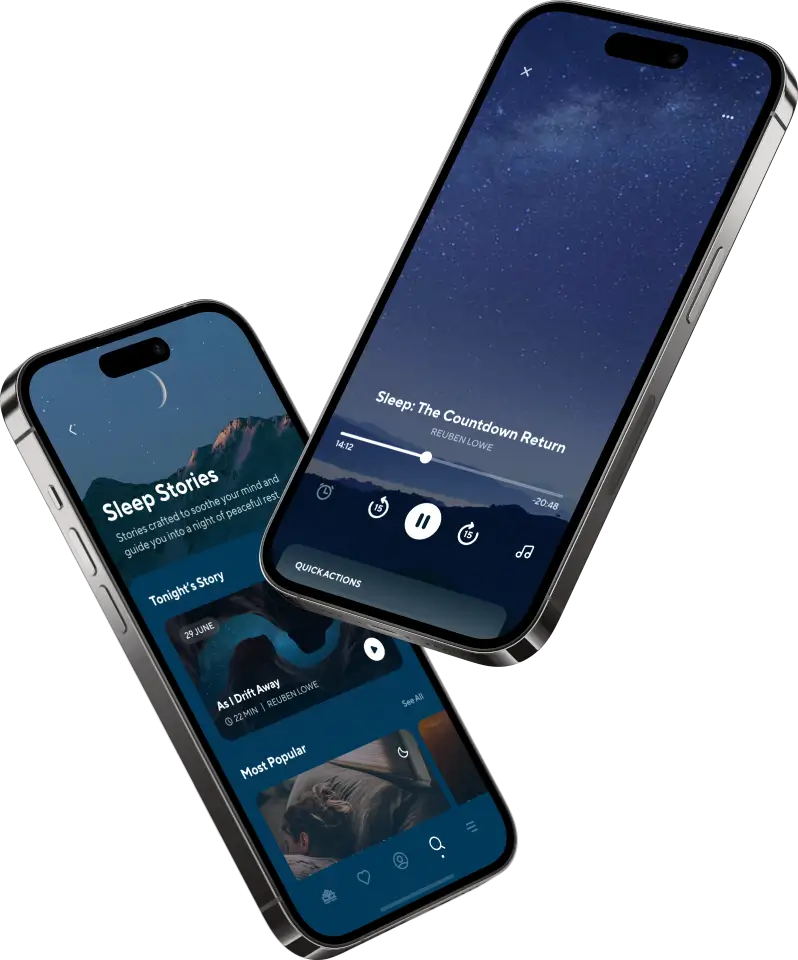Struggling to fall asleep? Mindfulness techniques can help. Stress and poor sleep often create a vicious cycle, but mindfulness interrupts this by calming your mind and body. Research shows that mindfulness practices like meditation, deep breathing, and body scans improve sleep quality and reduce insomnia. Here are six simple strategies you can try tonight:
- Guided Sleep Meditation: Focuses your mind and promotes relaxation through breathing, body scans, and visualization.
- Deep Breathing Exercises: Techniques like the 4-7-8 method calm your nervous system and reduce stress.
- Body Scan Meditation: Helps you release tension by focusing on each part of your body.
- Mindful Journaling: Clears mental clutter by letting you process thoughts and emotions before bed.
- Progressive Muscle Relaxation (PMR): Relieves physical tension by systematically tensing and relaxing muscle groups.
- Sleep Stories and Calming Audio: Redirects racing thoughts with soothing narratives or ambient sounds.
Each method is easy to incorporate into your nightly routine and can lead to better, more restorative sleep. Keep reading for step-by-step instructions and tips to get started.
Guided Sleep Meditation, Mindfulness Body Meditation, Awareness of Breath and Body Meditation
1. Guided Sleep Meditation
Guided sleep meditation helps shift your mind from a state of worry to one of calm. When your thoughts are consumed by tomorrow's tasks or the stresses of the day, this practice encourages relaxation and prepares your body for rest.
The process works by slowing your breathing and reducing your heart rate, helping your body transition from an alert state to the parasympathetic mode necessary for deep sleep. Over time, consistent practice can make falling asleep easier and improve the quality of your rest by quieting those persistent, racing thoughts.
Dr. Herbert Benson, director emeritus of the Harvard-affiliated Benson-Henry Institute for Mind Body Medicine, puts it this way:
"Mindfulness meditation is just one of a smorgasbord of techniques that evoke the relaxation response."
How to Practice Guided Meditation Before Bed
Starting a guided sleep meditation routine is easier than you might think. The key is to approach it with an open mind and without pressuring yourself to fall asleep. As Dr. Mark Bertin explains:
"In considering any meditation related to sleep, recognize that there's nothing to force, and nothing to make happen. Since striving makes sleep more challenging, set out to practice without specific expectations or goals."
Begin by lying down in a comfortable position. Keep your legs slightly apart and your arms relaxed at your sides or resting on your stomach. This posture signals to your body that it’s time to wind down.
Focus on your breathing, observing the gentle rise and fall of your belly. This helps anchor your mind, steering it away from stressful or intrusive thoughts. If your mind begins to wander, acknowledge the thought without judgment and gently bring your attention back to your breath.
Incorporating a body scan can enhance relaxation. Start at your feet and work your way up, noticing any sensations or tension. With each area, consciously release the tension and allow your body to relax further.
If you’re still feeling restless, return to your breath. Counting each inhale and exhale can provide additional focus and help quiet an active mind.
Many guided meditations combine techniques to deepen relaxation. A body scan, for instance, can heighten awareness of tension, encouraging you to release it. Breathing exercises, including gentle counting, signal to your body that it’s time to sleep. Visualization techniques, like imagining a serene landscape, can also help distract from daily worries and guide you toward calm.
For the best experience, dim your device screen when listening to a guided meditation. Focus on the guide’s voice, and if your mind drifts, gently redirect your attention to their instructions. Over time, regular practice paired with good sleep habits can amplify the benefits.
These steps can help you get the most out of the guided meditations available on The Mindfulness App.
Sleep Meditations on The Mindfulness App

The Mindfulness App offers an extensive library of guided meditations designed specifically for sleep. With over 500 tracks, you’ll find meditations tailored to address various challenges, such as racing thoughts or physical tension.
These sessions incorporate techniques like body scans, breathing exercises, visualization, and gratitude practices, all led by experienced meditation teachers. Each meditation is crafted to help you transition smoothly from wakefulness to sleep, with options ranging in length to fit your schedule.
The app is highly user-friendly. It’s available in 12 languages and offers offline access, making it convenient to use anytime. A 14-day free trial grants full access to the premium library, allowing you to explore different styles and find what works best for you.
2. Deep Breathing Exercises
Deep breathing exercises, much like guided meditations, are a simple yet powerful way to calm your mind and relax your body. They help shift your body from a state of alertness to one of tranquility, making them a go-to technique for managing stress and anxiety.
The science backs this up. When we're stressed, our breathing often becomes shallow, which can heighten feelings of anxiety. On the flip side, deep, controlled breathing can help your body settle down. The best part? You don’t need any special equipment, and you can do it virtually anywhere.
Dr. Melissa Young, an expert in integrative medicine, highlights the benefits:
"Yoga breathing techniques calm the body down and bring it into a more relaxed state. This kind of breathing can help us focus our mind and our body away from worries and repetitive thoughts."
Studies show that deep breathing can lead to increased heart rate variability, reduced blood pressure, and lower levels of stress hormones. Even just five minutes of slow, deliberate breathing can make a noticeable difference in reducing stress and anxiety.
The 4-7-8 Breathing Method
One of the most well-known techniques is the 4-7-8 breathing method, which has its roots in the ancient yogic practice of pranayama. The method is simple: inhale for 4 seconds, hold your breath for 7 seconds, and then exhale for 8 seconds. This rhythmic pattern not only soothes a restless mind but also encourages your body to relax.
Dr. Olivia Hsu Friedman, a specialist in acupuncture and traditional Chinese medicine, explains its impact:
"The 4-7-8 breathing technique allows you to relax the sympathetic nervous system, which is responsible for the 'fight or flight response,' while it activates your parasympathetic nervous system to bring you back to a normal heartbeat, deeper breathing and a calmer mind."
Some users even claim that this method can help them fall asleep in under a minute. Supporting this, a 2022 study published in Physiological Reports found that practicing 4-7-8 breathing improved heart rate variability and blood pressure in young adults.
Here’s how you can try it yourself:
- Find a comfortable position, either sitting or lying down.
- Place the tip of your tongue against the ridge of tissue behind your upper front teeth, and exhale completely to empty your lungs.
- Inhale gently through your nose for 4 seconds.
- Hold your breath for 7 seconds.
- Exhale through your mouth for 8 seconds, creating a soft "whoosh" sound as you purse your lips.
- Repeat this sequence up to four times, and aim to practice it twice daily for optimal results.
Breathing Exercises on The Mindfulness App
For those looking to deepen their practice, The Mindfulness App offers guided breathing exercises tailored for relaxation and better sleep. With step-by-step guidance from experienced instructors, the app makes it easy to follow along, even if you're new to these techniques.
The app complements the 4-7-8 method with additional practices, such as abdominal breathing to engage the diaphragm fully or sessions that incorporate visualization and counting to enhance relaxation. You can start with shorter exercises and gradually work up to longer ones. Plus, the offline feature ensures you can practice anytime, even without internet access.
Whether you’re dealing with racing thoughts, muscle tension, or general restlessness, there’s likely a breathing exercise on The Mindfulness App that fits your needs. As Jack Feldman, PhD, a neurobiology professor at the University of California, Los Angeles, puts it:
"Slow breathing can be done anywhere and is noninvasive. That's the wonderful thing about it. There are no side effects. It's cheap. And everyone has had the experience of taking a single deep breath - you take one, and you feel it; it's relaxing. Imagine doing that for 30 minutes and on a regular basis."
3. Body Scan Meditation
Body scan meditation is a mindfulness practice where you focus on each part of your body, one at a time, from head to toe. This technique helps you tune into physical sensations and emotions while easing any tension that might be disrupting your sleep. By incorporating this into your nightly routine, you create a gentle signal for your body to shift into relaxation mode, much like breathing exercises or guided meditation.
What makes body scan meditation so approachable is its straightforwardness. Dr. Melissa Young describes it perfectly:
"It's about taking time to scan through all parts of the body from head to toe and checking in with the sensations in the body. How does the body feel?"
Studies back up its benefits, particularly for improving sleep. A 2019 review found that mindfulness meditation techniques, including body scans, can help address sleep problems and enhance sleep quality. Another study showed that participating in an eight-week mindfulness program reduced cortisol levels - a stress hormone often linked to sleep disturbances. Regular practice has been associated with easing stress, lowering inflammation, and combating fatigue and insomnia. If you notice tension in specific areas during your scan, try breathing deeply into those spots and visualizing the tension melting away with each exhale.
How to Do a Body Scan
After trying guided meditations or breathing techniques, a body scan can take your relaxation to the next level. It’s easy to get started, and since it can be done lying down, it’s perfect for bedtime. Find a quiet, comfortable place, settle into a relaxed position, and decide whether to close your eyes or keep them partially open - whatever helps you focus.
Begin by taking a few deep breaths. Then, slowly shift your attention from the top of your head down to your toes, noticing any sensations as you go. There’s no need to judge or change what you feel - the goal is simply to observe. You might notice tingling, tightness, warmth, or even coolness, and all of these are perfectly normal.
Move through your body step by step: start with your forehead, eyes, jaw, and neck, then work down to your shoulders, arms, and hands. Continue through your chest, back, belly, hips, legs, and finally your feet and toes. If you come across areas of discomfort or tension, focus your breath on those spots and imagine the tightness easing with every exhale. If your mind wanders, gently bring it back to the sensations in your body.
Body Scan Sessions on The Mindfulness App
To support your practice, The Mindfulness App offers guided body scan meditations tailored for relaxation and sleep. These sessions are led by experienced instructors, making them beginner-friendly, and they come in various lengths so you can start small and work your way up as you grow more comfortable.
What sets these sessions apart is their focus on preparing you for restful sleep. They combine visualization techniques with breathing prompts to help you release tension effectively. Plus, with offline access, you can practice without interruptions.
Dr. Young highlights the lasting impact of this practice:
"When you practice this technique and incorporate it into your self-care routine, your nervous system starts to remember how to relax."
The Mindfulness App features over 500 guided tracks, offering a range of body scan styles, from traditional step-by-step scans to those that blend in progressive muscle relaxation. This variety keeps your practice engaging while helping you develop a skill that promotes better sleep.
sbb-itb-bea8dce
4. Mindful Journaling
When your thoughts are racing and sleep feels out of reach, mindful journaling can help quiet your mind and prepare you for rest. This practice involves writing down your thoughts without judgment, giving you a way to process emotions and let go of mental clutter. Decades of clinical research have shown that mindful writing can improve sleep quality and reduce nighttime stress.
The calming effect of mindful journaling comes from its ability to naturally soothe the nervous system. As Mindful.org explains:
"Writing focuses our attention, because we can only write about one thing at a time. In this process of slowing down, our breathing regulates, our thoughts become less jumbled, and we experience the relief of expressing hidden thoughts. Often just naming an experience or emotion has the effect of bringing more calm."
Studies also highlight the physical and emotional benefits of this practice. Writing about difficult experiences has been shown to lower blood pressure, stabilize breathing, improve sleep, and even strengthen the immune system. By transferring your worries onto paper, you free up mental space that might otherwise keep you tossing and turning. Instead of letting anxieties loop endlessly in your mind, journaling helps create a sense of order, making it easier to relax and drift off to sleep.
How to Journal Mindfully at Night
Like other mindfulness practices, journaling helps shift your focus from a state of alertness to one of relaxation. It doesn’t require fancy tools - just a pen and paper or a journaling app will do. The most important part? Consistency. Let go of concerns about grammar or structure and simply write freely.
Set the stage for relaxation by dimming the lights, lighting a candle, or using calming essential oils. Once you’re ready, try the brain dump method: set a timer for 20 minutes and write continuously, letting your thoughts flow in a stream-of-consciousness style.
If you prefer a bit more structure, guided prompts can be helpful. For example:
- What thoughts or worries do I need to release before sleep?
- What challenges did I face today?
- What moments brought me gratitude?
- What was the highlight of my day?
Another useful approach is worry listing. Write down your concerns along with any related thoughts, and then explore both the best-case and worst-case outcomes. If your mind is preoccupied with tomorrow’s tasks, jot down a to-do list to lighten the mental load.
The University of Rochester Medical Center emphasizes how journaling can bring clarity and calm:
"Keeping a journal helps you create order when your world feels like it's in chaos. You get to know yourself by revealing your most private fears, thoughts, and feelings. Look at your writing time as personal relaxation time. It's a time when you can de-stress and wind down."
After journaling, avoid screens and focus on easing into sleep to maintain the relaxed state you’ve achieved.
Journaling Support from The Mindfulness App
If you’re looking for additional guidance, The Mindfulness App offers tools to enhance your journaling practice. With features like guided prompts and audio support, it’s designed to help you reflect and unwind at night.
The app includes meditation-based prompts that encourage reflection on insights gained from mindfulness practices, such as breathing exercises or body scans. This creates a seamless connection between meditation and journaling, making it easier to integrate these habits into your bedtime routine.
For added convenience, the app works offline, so you can access journaling prompts even without internet access. Its guided audio instructions provide gentle tips for reflective writing, making it accessible for beginners and seasoned journalers alike. Plus, with content available in 12 languages, you can express your thoughts in the language that feels most natural to you, fostering the unfiltered and honest expression that makes mindful journaling so effective for sleep preparation.
5. Progressive Muscle Relaxation
Ever had one of those days when stress lingers in your body, making it impossible to fall asleep? Shoulders feel stiff, your jaw is clenched, and your back aches from hours of poor posture. That’s where Progressive Muscle Relaxation (PMR) steps in - a technique designed to release physical tension and prepare your body for deep, restorative sleep.
PMR works by tensing and then relaxing specific muscle groups throughout your body. At first, it might seem strange to intentionally tighten your muscles just to relax them. But this process activates your parasympathetic nervous system, which helps calm both your mind and body.
Dr. Matthew Kampert, a sports medicine physician, describes the dual benefits of PMR:
"Progressive relaxation is like a body scan that has a mental component and a physiological component. It involves using breathing and visualization to help you acknowledge and release the tension you hold in every area of your body."
The Science Behind PMR and Sleep
The sleep-enhancing effects of PMR are backed by research. A 2020 study on 80 burn patients with anxiety and poor sleep quality found that those who practiced PMR for 20–30 minutes daily over three days experienced significant anxiety reduction and better sleep compared to those receiving routine care. Another study examining stress-related insomnia reported that practicing PMR for 30 minutes over five days reduced anxiety scores by about 15% and improved sleep quality scores by over 30%.
Dr. Kathryn A. Boling, a family medicine specialist, highlights PMR’s ability to quiet a racing mind:
"PMR pushes all those thoughts that we go over each night out of our heads and forces us to focus on one thing – relaxing."
She even notes:
"Some people fall asleep before they even finish their progressive muscle relaxation exercises."
How to Practice Progressive Muscle Relaxation
PMR is simple, requires no special tools, and can be done while sitting or lying down - perfect for winding down before bed. The technique involves working through your body systematically, tensing each muscle group for about 5 seconds as you inhale, then releasing the tension as you exhale.
Here’s a step-by-step guide to get started:
- Feet and toes: Curl your toes tightly, hold for 5 seconds, then release.
- Calves: Point your toes downward to engage the muscles, then relax.
- Thighs: Lift your legs slightly if lying down, or press them into your seat if sitting, then release.
- Buttocks and lower back: Squeeze your glutes and arch your lower back slightly, then let go.
- Abdomen: Push your stomach out as far as possible, then relax it completely.
- Arms: Clench your fists, bend your elbows to tense your biceps, then straighten your arms to engage the triceps before relaxing.
- Shoulders: Shrug them toward your ears, then let them drop.
- Neck: Press your head gently back, then lower it toward your chest.
- Face: Wrinkle your forehead, close your eyes tightly, clench your jaw, press your tongue against the roof of your mouth, and purse your lips - then relax all at once.
After tensing and releasing each muscle group, take 10–20 seconds to fully enjoy the sensation of relaxation. If any areas still feel tense, repeat the process. Many people find it helpful to internally say “RELAX” with each release.
According to Luis F. Buenaver, a sleep expert at Johns Hopkins:
"With practice, your body and mind will learn to relax more quickly and deeply for fewer sleepless nights."
Guided PMR Sessions: The Mindfulness App
While PMR can be done independently, guided sessions can make the process easier - especially for beginners. The Mindfulness App offers guided PMR tracks specifically designed for bedtime, with clear instructions that ensure you target each muscle group effectively.
These sessions include soothing narration, breathing cues, and visualization techniques to help you ease into relaxation without overthinking the steps. Whether you prefer a quick 10–15 minute practice on busy nights or a longer 20–30 minute session when you have extra time, these guided options make it simple to incorporate PMR into your routine.
Available in 12 languages and accessible offline, the app ensures you can practice PMR anywhere, anytime. It’s an easy way to bring calm and relaxation into your nightly routine.
6. Sleep Stories and Calming Audio
When your mind won’t stop racing at bedtime, sleep stories and calming audio can gently guide your thoughts elsewhere. Unlike active techniques that require effort, listening to sleep stories is a passive yet effective way to settle your mind and prepare for sleep. Much like guided meditations or breathing exercises, these audio tools provide a simple path to relaxation as you wind down.
Studies suggest that listening to soothing words before and during the early stages of sleep can increase the time spent in deep sleep. By giving your mind something peaceful to focus on, these audio experiences help slow down your thoughts and heart rate, creating the perfect environment for restorative rest.
How Sleep Stories Help You Rest
Sleep stories act as a calming bridge between being awake and falling asleep. Chris Advansun, a specialist in creating sleep-focused content, explains:
"The main thing we're solving for is thoughts at night. So many of us go to drift off and we have what scientists who study this call 'sleep disturbance.'"
These stories give your mind a gentle focal point without requiring active engagement. Beyond sleep stories, calming audio - like the sound of rustling leaves or gentle rainfall - can lower your heart rate and block out disruptive background noise. Soundscapes such as white, pink, brown, and green noise each offer unique ways to mask distractions and promote relaxation. Together, these options create a soothing auditory experience that complements a good sleep routine.
The benefits of these tools are clear. In an online survey, 62% of respondents reported using music to help them sleep, and over half of those with diagnosed sleep disorders use music as a sleep aid. With approximately 70 million Americans affected by sleep disorders - and 33% to 55% dealing with chronic insomnia - sleep stories and calming audio provide a non-medicated way to improve rest.
Sleep Stories on The Mindfulness App
The Mindfulness App offers a thoughtfully curated library of sleep stories and calming audio tracks designed to help you transition smoothly from wakefulness to sleep. These recordings are crafted with mindfulness principles, providing a calming and grounding experience that helps you unwind without overstimulation. The stories range from serene nature scenes to gentle journeys, all narrated in soothing voices that encourage relaxation.
In addition to the stories, the app includes a rich collection of ambient music and nature sounds. These tools are available in 12 languages and can be accessed offline, allowing you to maintain a consistent, relaxing bedtime routine without worrying about internet access or blue light exposure. To get the most out of these features, try listening at the same time each night, use a sleep timer, and create a playlist of soft, calming tracks tailored to your preferences.
As Chris Advansun aptly puts it:
"You're lying there, it's intimate, you want to feel like you're in good hands."
With its soothing voices and tranquil sounds, The Mindfulness App helps guide you into a restful night’s sleep.
Conclusion: Creating Your Nightly Mindfulness Routine
Establishing a mindfulness routine takes time and dedication, but starting small can make it manageable. Begin with one or two techniques that resonate with you. As mindfulness coach and author Maria Gonzalez says:
"If someone were to follow their breath, 10 minutes a day, every single day, I would be really surprised if they didn't experience benefits."
The key is consistency, not perfection. Dr. Elizabeth Seng, Associate Professor of Psychology at Yeshiva University, advises:
"Choose the practice you're most likely to maintain. That can be more important than starting a stopwatch."
To make mindfulness a habit, tie it to daily routines like brushing your teeth or sipping tea. Simple reminders - like alarms or sticky notes - can help until it becomes second nature. These small changes can lead to lasting improvements in your sleep quality.
Research supports this. Studies show that just 8 weeks of regular meditation can significantly enhance sleep quality. For example, practicing 13 minutes of daily meditation over this period has been linked to better memory, improved emotional regulation, and a more stable mood. Whether through guided meditations, breathing exercises, or other techniques, consistent mindfulness can lead to better rest. While some people notice changes quickly, patience is essential as progress often unfolds gradually.
It's also important to address habits that might disrupt your sleep. Creating a calming evening environment - by dimming lights, putting away screens, and sticking to a set bedtime - can make a big difference. Interestingly, workers who took mindful breaks during the day reported feeling more energized and focused, which can contribute to better sleep at night.
Mindfulness is a skill that grows with practice. Some nights, a quick breathing exercise might be all you need; other evenings may call for a full body scan. The most important thing is to keep practicing, even if it’s just a minute of mindful breathing. As one meditation guide wisely notes:
"Mindfulness is about mindfulness, not perfection."
The Mindfulness App offers all six techniques discussed in this article, available in 12 languages and accessible offline. It’s a handy tool to help you maintain your routine whether you’re at home or traveling.
Finally, end your day with reflection and gratitude to transition from daytime activities to restful sleep. The Mindfulness App can help you seamlessly incorporate these practices into your nightly routine, making mindfulness a natural part of your evening.
FAQs
How long does it take for mindfulness to improve sleep?
Many individuals find that dedicating just 10 to 20 minutes a day to mindfulness can lead to noticeable improvements in their sleep. While some might feel the effects within a few days, studies show that practicing consistently for 8 weeks often brings deeper and more enduring benefits.
It's important to note that results can vary from person to person. The real secret is to remain patient and make mindfulness a consistent part of your evening routine.
Can I combine mindfulness techniques with other treatments to improve sleep?
Mindfulness techniques can be a valuable addition to other sleep treatments, such as medication or cognitive-behavioral therapy for insomnia (CBT-I). When used together, these approaches may improve sleep quality, help manage stress, and potentially decrease the need for long-term sleep aids.
Practices like guided meditations or breathing exercises work well alongside other treatments because they target the mental and emotional challenges that often disrupt sleep. However, it’s important to consult your healthcare provider to make sure this combination suits your individual needs.
What can I do if I struggle to focus during mindfulness exercises before bed?
It's perfectly natural to find your mind wandering during mindfulness exercises, especially after a long, tiring day. When this happens, don't be hard on yourself. Instead, gently redirect your focus back to your breath or the sensations in your body. The key is to approach this process with patience and without self-judgment - progress takes time and consistency.
If staying focused feels challenging, consider starting with shorter sessions or using a guided meditation. These tools can help you stay on track as you build your practice. With regular effort, you'll find it becomes easier to stay present and settle your mind before bedtime.






